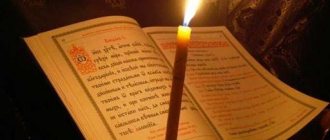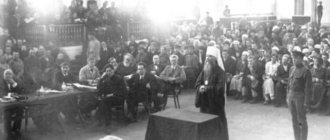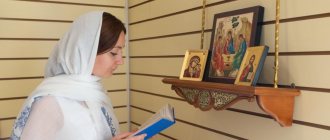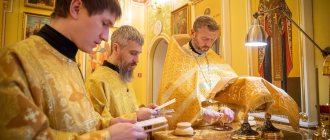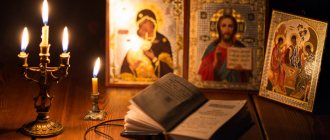The concept and meaning of the akathist in Orthodoxy
An akathist is a church hymn to the Lord, the Mother of God, and the saints, sung while standing. The tradition of singing songs of praise originated in ancient Greece during the Byzantine period. The first song prayer known to this day is the Great Akathist to the Most Holy Mother of God.
It was written after the siege of Constantinople in 626. An eyewitness to the siege, Sinkell, claimed that the Holy Virgin showed her power by intervening in the battle at sea. The barbarians on the boats crashed near the Blachernae Church of the Theotokos.
After divine deliverance from the barbarian raid, the emperor of the Eastern Roman Empire considered the Mother of God to be the Patroness of his capital. The prayer service was performed in the Blachernae Church, where the miraculous icon of the Holy Virgin, her belt and robe were kept. Subsequently, the ritual spread to the entire Orthodox Church.
Subsequent chants were composed by analogy with the original model, which made the hymn a special genre, a form of church poetry. A poetic text has a special structure. It includes 25 songs arranged in the Greek alphabet.
There is a main kontakion, which has a specific ending or chorus, and 12 kontakia interspersed with ikos. At the end of each ikos, “Rejoice!” is said, and the kontakia ends with “Hallelujah!” The 13th Kontakion is repeated three times, then the first Irmos is sung.
The authors of the texts were theologians, holy fathers, and Orthodox poets. In the Russian Orthodox Church, hymns are written not only for the Mother of God, Jesus Christ, but also for each glorified saint, as well as for some holidays. The first Russian solemn prayer was dedicated to Sergius of Radonezh.
The peculiarity of performing the hymn is that it can be performed at home, without a priest or choir.
Icon of the Mother of God “Vsetsaritsa (Pantanassa)” and Holy Mount Athos
According to folk tradition, they pray for the healing of cancer patients in front of the icon “The Queen of All” or, in Greek, “Pantanassa”. This icon appeared and gained fame in the Vatopedi monastery, located on Mount Athos. According to legend, the Most Holy Theotokos, accompanied by John the Theologian, went to Cyprus in 48. However, the ship, caught in a storm, was forced to land at Mount Athos. Admired by the extraordinary beauty of the peninsula, the Most Holy Mary wished to stay here to preach the Gospel. It is generally accepted that Jesus Christ Himself, at the request of His mother, made Athos her destiny.
Athos is still considered a special place among Christians. Since 1046, it officially acquired the name “Holy Mountain”. Life here flows according to its own special laws. This is a place of special monastic prayer. Today there are twenty male monasteries on Athos, and both the creation of new monasteries and the abolition of existing ones are prohibited by Athos laws. A large number of Orthodox shrines are kept in the monasteries of Athos. Among them are about sixty revered icons of the Blessed Virgin Mary. One of these icons is “Pantanassa”
The icon “The Queen of All” has been known since the seventeenth century. The story of Elder Joseph the Hesychast, who lived on Mount Athos for many years, to his disciples has been preserved. One day (in the seventeenth century) a strange-looking young man appeared in front of the icon “The Queen of All.” He stood for a long time in front of the icon of the Mother of God, muttering something. Suddenly, something like lightning flashed in the face of the Mother of God, and the young man was thrown to the ground by some unknown force. Having come to his senses, the young man wanted to confess and admitted to the priest that he was interested in magic and had arrived at the monastery to test his magical abilities in front of the holy icons. After a miracle happened to him, the man completely changed his life, left his magical pursuits and stayed in the monastery. This was the first miracle that occurred from the “Vsetsaritsa”.
All in the same seventeenth century, one of the Greek monks made a copy of the miraculous icon. People who prayed in front of the icon began to notice that its effect on patients with malignant tumors was especially beneficial. Over time, the icon of the All-Tsaritsa became famous as an assistant in the healing of cancer patients.
When to read the akathist correctly at home
The Charter of the Orthodox Church obliges the sung of the akathist on Saturday of the fifth week of Great Lent (other solemn hymns are prohibited during Great Lent). Sometimes solemn prayers are sung at matins or a prayer service in honor of some holiday. In other cases, singing a solemn hymn in honor of Jesus Christ, the Mother of God, or some saint is the work of a believer; there are no other rules.
Reading the akathist is a spiritual strain that not every believer can withstand. To strengthen your strength, you should ask for a blessing from your confessor.
The prayer is read in a special order.
Before beginning the hymn, the following prayers should be read:
- "In the name of the Father and the Son and the Holy Spirit, Amen."
- (Prayer of the Publican from the Gospel of Luke). “God, be merciful to me, a sinner.” (Bow).
- (Pre-initial). “Lord Jesus Christ, Son of God, prayers for the sake of Your Most Pure Mother, our reverend and God-bearing fathers and all the saints, have mercy on us. Amen. Glory to Thee, our God, glory to Thee.”
- "To the Holy Spirit."
- "Trisagion" It is pronounced 3 times, with the sign of the cross and a bow from the waist.
- "Holy Trinity". (“Lord, have mercy” is read 3 times).
- "Our Father".
- "Virgin Mother of God, rejoice."
- “Lord, have mercy” (12 times).
- “Come, let us worship our God the King (Bow). Come, let us worship and fall down before Christ, our King God. (Bow). Come, let us bow and fall down to Christ Himself, the King and our God” (Bow).
- Psalm 50.
- "Symbol of faith".
The initial prayers change from Easter to Ascension; instead of addressing the Holy Spirit, they read: “Christ is risen from the dead, trampling down death by death, and giving life to those in the tombs.” (Repeat 3 times). From Ascension to Trinity the text is not read.
After the introduction, the reading of the anthem begins. The prayer ends with an appeal to the Most Holy Theotokos:
“It is worthy to eat, for truly to bless You, Theotokos, Ever-Blessed and Most Immaculate and Mother of Our God. The most honorable Cherub and the Most Glorious without comparison Seraphim, who without corruption gave birth to God the Word, the real Mother of God, we magnify You.”
Then follows:
- “Glory to the Father and the Son and the Holy Spirit, now and ever and unto ages of ages. Amen".
- “Lord, have mercy” (3 times).
- “Lord Jesus Christ, Son of God, prayers for the sake of Your Most Pure Mother, our reverend and God-bearing fathers and all the saints, have mercy and save me, a sinner, as I am Good and Human darling. Amen".
Options if the appeal was to a saint, the Cross of the Lord or an angel:
- “Lord Jesus Christ, Son of God, prayers for the sake of Your Most Pure Mother, our reverend and God-bearing fathers, the saint (the name of the saint to whom the akathist was read), have mercy and save me, a sinner, as Good and Lover of Mankind. Amen".
- “By the power of the Honest and Life-giving Cross, have mercy and save me, a sinner, as I am Good and Lover of Mankind. Amen".
- “Honest Heavenly Powers of the Bodiless, have mercy and save me, a sinner, as you are Good and Lover of Humanity. Amen".
The prayer service ends with the sign of the cross and a bow from the waist.
Schedule by days of the week
In home worship, it is customary to adhere to the church rule: during the week, remember the same events and saints as in church.
Monday
On the first day of the week, the Heavenly protectors (personal and all-Christian) are commemorated. The Akathist is sung either to the Guardian Angel or to the Archangel Michael.
Tuesday
The next day, they remember John the Baptist, the predictor of the coming of the Savior, who called on the Jews to repent of their sins. In the solemn hymn, the prophet is praised as the forerunner of Christ in earthly life and hell, introducing the rite of baptism by water, baptizing Jesus in the Jordan River.
Wednesday
In the middle of the week, an akathist is sung in honor of Jesus (the Sweetest Jesus) or the Mother of God. The hymns are dedicated to the life of Christ and the memory of the Blessed Virgin.
Thursday
On this day, they solemnly commemorate the closest disciples of Jesus Christ, Peter and Paul, as well as their successors in the spread of Christianity: Nicholas the Wonderworker and the holy apostles.
Friday
Friday is the day when Christ was crucified on the cross. They read an akathist dedicated to the suffering of Jesus on the cross and the miraculous Cross of the Lord.
Saturday
On Saturday they sing the hymn to the Council of New Martyrs and Confessors of the Russian Church or the Mother of God. The meaning of the akathist is the remembrance of all the departed.
Sunday
On Sunday they sing a hymn in remembrance of the Resurrection of Christ.
List of Orthodox akathists
The Orthodox prayer book contains a list of all the akathists of the Russian Orthodox Church.
Mother of God
Akathists of the Mother of God are read in honor of her icons:
- "Unexpected joy." Thanks for the miraculous healing.
- "Inexhaustible Chalice" They ask to be cured/cured from the vice of drunkenness and drug addiction.
- "The Queen of All." They ask for help with cancer, problems with naughty children.
- "Tenderness." Prayer of thanksgiving.
- "Healer" They pray in front of the icon for deliverance from serious illnesses.
- "Quick to Hear." The holy image is located on Mount Athos. Miraculous power was manifested when dealing with painful conditions.
- "Joy to all who mourn." Prayer of thanksgiving.
- "Upbringing". Parents who want to find a common language with their children receive effective help.
- "Mammal". Pregnant women turn to the icon asking for a safe birth and healthy babies.
- "Burning bush". The Mother of God will help you escape from a fire and avoid illegal persecution.
- "Kazanskaya". At home, they offer her prayers to save the marriage and cure her blindness.
- "Protection of the Most Holy Theotokos." At home they pray at the icon to strengthen their faith.
- "Quiet my sorrows." The Akathist is read in front of the holy image when one is overcome by everyday adversity.
- "Softening Evil Hearts." They pray to the icon when children quarrel with their parents.
An appeal to the Mother of God pacifies the believer’s soul and gives hope for healing or a solution to a problem.
Angels and Saints
Angels and saints to whom you can serve a prayer service with the reading of the akathist at home:
- Spyridon of Trimifuntsky;
- John the Baptist;
- archangel Michael;
- noble princes Peter and Fevronia of Murom;
- St. George the Victorious;
- Panteleimon the Healer;
- John the Warrior;
- Tikhon of Voronezh Zadonsky;
- Alexander Svirsky;
- Nicholas the Wonderworker;
- Matrona of Moscow;
- Luke of Simferopol;
- Vasily Ostrogsky;
- Elizaveta Alapaevskaya;
- John of Kronstadt;
- Seraphim of Sarov;
- Ksenia Petersburgskaya;
- Council of New Martyrs and Confessors of the Russian Church;
- Harlampy of Magnesia;
- John Chrysostom;
- martyrs Faith, Hope, Love and their mother Sophia;
- Innocent of Moscow;
- Sergius of Radonezh;
- Hieromartyr Cyprian and Martyr Justina;
- Alexy Moskovsky;
- Alexander Nevskiy;
- Catherine of Alexandria;
- Varvara Iliopolskaya;
- Boniface of Tarsus.
The Akathist is sung on any day of the week, at morning or evening prayer.
Women's monastery in honor of the icon of the “Vsetsaritsa” in Krasnodar
There is a monastery in Russia dedicated to the famous icon of the Mother of God “The Tsaritsa”. It is located in Krasnodar. The main shrine of the monastery is the “Vsetsaritsa” - an exact copy of the Athonite icon. The list was made in 2005 by a Russian master icon painter from Pereslavl-Zalessky Valery Polyakov. On Easter, Archimandrite Ephraim of Vatopedi served a special prayer service, at which the newly painted icon was consecrated. After the prayer service, the icon was placed on more than a hundred Vatopedi shrines, including the Belt of the Most Holy Theotokos.
The icon was delivered with great honors from Athos to Krasnodar. Since then, services to the All-Tsaritsa have been regularly performed in the monastery: akathist, prayers, prayer services. Patients of the Krasnodar Regional Oncology Center became frequent participants in the prayer singing. Many of them came to the temple quite recently, having learned about their terrible diagnosis. In the hope of a miracle, they turn with sincere prayer to the Most Pure Mother of God.
